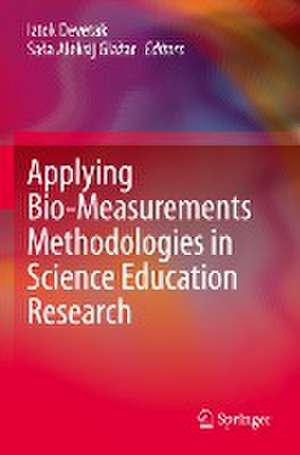Applying Bio-Measurements Methodologies in Science Education Research
Editat de Iztok Devetak, Saša Aleksij Glažaren Limba Engleză Paperback – 29 mai 2022
| Toate formatele și edițiile | Preț | Express |
|---|---|---|
| Paperback (1) | 641.85 lei 6-8 săpt. | |
| Springer International Publishing – 29 mai 2022 | 641.85 lei 6-8 săpt. | |
| Hardback (1) | 648.24 lei 6-8 săpt. | |
| Springer International Publishing – 28 mai 2021 | 648.24 lei 6-8 săpt. |
Preț: 641.85 lei
Preț vechi: 755.13 lei
-15% Nou
Puncte Express: 963
Preț estimativ în valută:
122.83€ • 126.89$ • 102.23£
122.83€ • 126.89$ • 102.23£
Carte tipărită la comandă
Livrare economică 25 martie-08 aprilie
Preluare comenzi: 021 569.72.76
Specificații
ISBN-13: 9783030715373
ISBN-10: 303071537X
Ilustrații: XVI, 311 p. 75 illus., 64 illus. in color.
Dimensiuni: 155 x 235 mm
Greutate: 0.46 kg
Ediția:1st ed. 2021
Editura: Springer International Publishing
Colecția Springer
Locul publicării:Cham, Switzerland
ISBN-10: 303071537X
Ilustrații: XVI, 311 p. 75 illus., 64 illus. in color.
Dimensiuni: 155 x 235 mm
Greutate: 0.46 kg
Ediția:1st ed. 2021
Editura: Springer International Publishing
Colecția Springer
Locul publicării:Cham, Switzerland
Cuprins
Chapter 1. Cognitive Processes and Eye-Tracking Methodology (Anja Podlesek).- Chapter 2. The Interplay of Motivation and Visual Attention in Understanding Science Concepts (Mojca Juriševič).- Chapter 3. Predicting Task Difficulty by Means of Psychophysiology (Junoš Lukan).- Chapter 4. Discussion of Visual Attention for Solving Multiple Choice Science Problem: An Eye-Tracking Analysis (Miroslawa Sajka).- Chapter 5. The Application of Eye Tracking to Chemistry Education Research – A Review of the Literature (Jessica R. VandenPlas).- Chapter 6. Using Eye-Tracker to Study Students' Attention Allocation During Solving Tasks of Specific States of Water Comprising Dynamic 3D Submicrorepresentations (Miha Slapničar).- Chapter 7. Students' Attention Allocation when Solving a Context-based Problem of Process During the Opening of a Bottle of Mineral Water (Jerneja Pavlin).- Chapter 8. Using Eye-Tracking Approach to Explain Students’ Achievements in Solving the Task about Burning by Applying Chemistry Triplet (Iztok Devetak).- Chapter 9. Reading Organic Chemistry Equations: An Eye-Tracking Study (Katherine L. Havanki).- Chapter 10. The Role of the Explanatory Key in Solving Tasks Based on Submicroscopic Representations (Špela Hrast).- Chapter 11. Use of Eye-Tracking and Electroencephalography to Study Student Use of Metabolic Pathways when Answering a Question (Kimberly Linenberger Cortes).- Chapter 12. Using Functions to Interpret some Physics Phenomena – an Eye-tracking Study (Miroslawa Sajka).- Chapter 13. Eye Movements as Indicators of Students' Understanding of Water Ballance in Plants (Anja Podlesek).- Chapter 14. Visualizing Student Navigation of Geologic Block Diagrams (Karen S. McNeal).
Notă biografică
Dr. Iztok Devetak is a Professor of Chemical Education at the Faculty of Education, University of Ljubljana, Slovenia. His research focuses on how students can learn chemistry, how chemistry in context stimulates learning and how eye-tracking technology explains science learning. His interest is also environmental education and developing health-managing competences for teachers. Having previously co-edited a Springer monograph on active learning approaches in chemistry, Dr. Devetak was a Fulbright Scholar with Prof. Dr. Diane Bunce in 2009, and is currently Chair of the Chemical Education Division at the Slovenian Chemical Society and vice-chair for Eastern Europe of European Chemical Society Division of Chemical Education and president of the National Subject Testing Committee for chemistry in lower secondary schools, as well as Editor-in-Chief of the CEPS Journal.
Dr. Saša A. Glažar is a Professor Emeritus at University of Ljubljana, Slovenia. His research is focussed mainly on the development of methodology for the organisation of chemical data into networks of knowledge and building chemical relational information systems to be applied in the transfer of knowledge in education and industrial development. Saša A. Glažar is involved in defining, classifying and categorisation of science concepts in building relational systems for various levels of education, structuring information into knowledge maps, i.e. hierarchically built relational systems in science education. The same approach was also applied in designing study programmes for all levels of education. As an expert, he participates in the development and evaluation of national science curricula and in international studies (TIMSS, PISA).
Textul de pe ultima copertă
This book illustrates the problems of using eye tracking technology and other bio-measurements in science education research. It examines the application of bio-measurements in researching cognitive processes, motivation for learning science concepts, and solving science problems. Most chapters of this book use the eye-tracking method, which enables following the focus of the students’ attention and drawing conclusions about the strategies they used to solve the problem. This book consists of a total of fifteen chapters. Authors from eight countries emphasise the same trends despite their cultural and educational differences. The book begins with general chapters describing cognitive processes and how these processes are measured using eye-tracking methods and other psychophysiology parameters and motivation. Finally, the book concludes the chapters presenting studies in specific scientific fields from chemistry, biology, physics and geology.
Caracteristici
Explores beyond paper-pencil measurements in researching teaching and learning science Presents conclusions that can be implemented in successful teaching and learning Examines the research of internationally respected science educators
